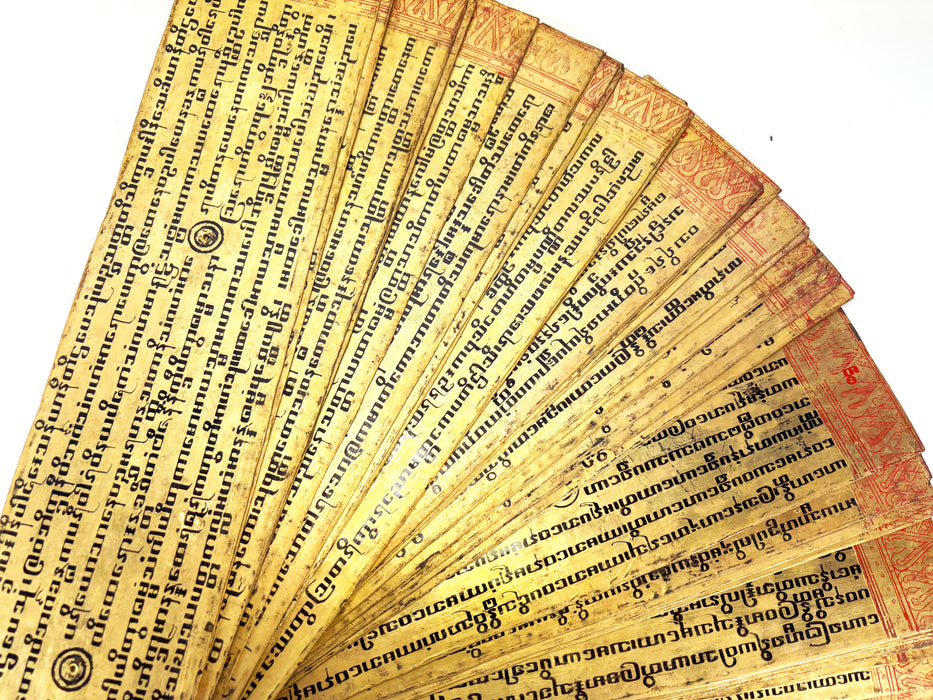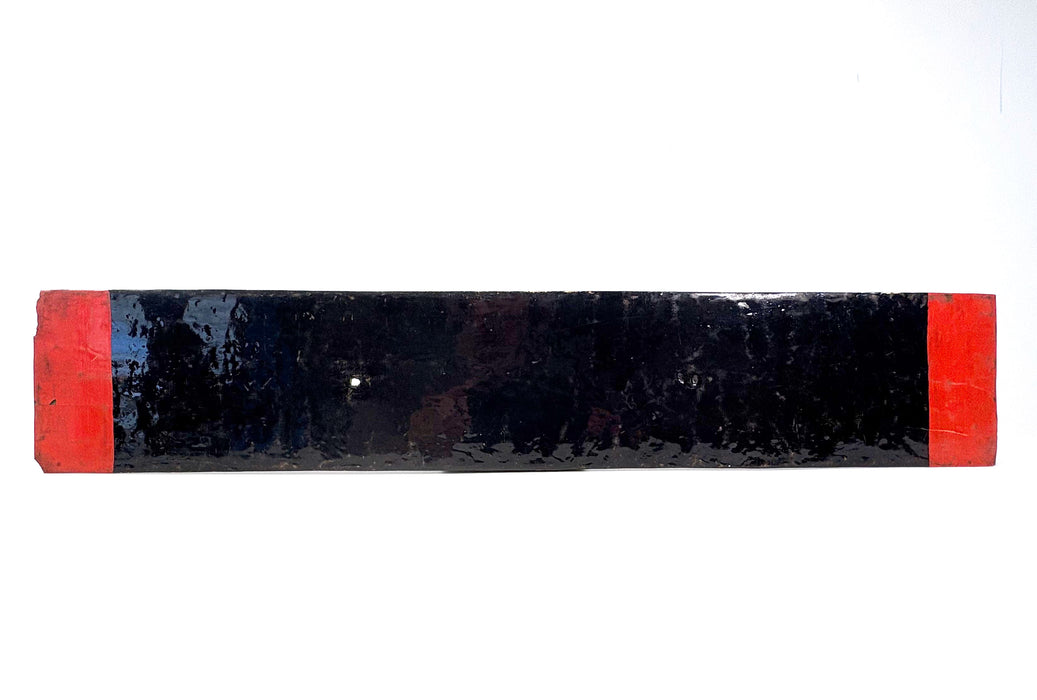
A Truly Outstanding Burmese Kammavaca Buddhist manuscript; 60 Leaves, Late Konbaung Dynasty: circa 1850-1885.
A Truly Outstanding Burmese Kammavaca Buddhist manuscript.
This richly decorated Burmese Kammavaca manuscript is an outstanding example of late 19th century Theravāda Buddhist ritual literature. Comprising nearly 60 gilded leaves inscribed in Pali using Burmese round script, the manuscript is complete and includes original red and gold lacquered wooden covers. Its contents follow the Upasampadā (ordination) liturgy with excerpts from the Vinaya Pitaka, including canonical formulae used in the formal initiation of monks.
The manuscript contains full kammavāca (ritual legal text) sequences for ordination, including the threefold announcement to the Saṅgha and canonical confirmations of acceptance. Texts open with the standard formula 'Evaṁ me sutaṁ…' and include doctrinal passages on the kusala/akusala roots, and the formal invitation to speech or silence during ordination. This indicates high ritual use and suggests monastic or lay commission of significant status.
The Kammacava manuscript from Burma offers the most ornate and decorated manuscript in Burmese culture. The pages gleam with gold and are ornately decorated throughout. Kammavaca texts typically contain religious instructions/rituals for monks. Each manuscript would have extracts from the Vinyana Pitaka. Such manuscripts were ceremonial objects and not just utilitarian texts.
It is still expected for all young men to spend a period of time in a vihara (monastery). Upon entering the monkhood, some parents may present a kammavaca to the presiding monk during their son's ordination ceremony. These manuscripts, produced by highly skilled craftsmen would be out of the reach of most people, making the one presented particularly special.
A typical kammavaca comprises 2 covers plus typically up to 16 folio leaves of text (but varies according to the content). This example is the highest number of leaves we have ever seen in person, comprising:
2 lacquered and gilded wooden covers;
2 black and red lacquered 'endpapers';
1 lacquered and gilded colophon leaf (internal title page); and;
55 individual leaf folios, with eight lines of Pali in Burmese round script per page, consistent with 19th Century ceremonial manuscripts.
The script remains crisp and highly legible.
This would make this manuscript a very high status item, specially commissioned by an individual of important personage.
The outer leaves are fashioned from lacquered teak wood to provide a rigid finish.
The folio leaves are also extensively lacquered and decorated with gold. It is difficult to establish the substrate they are built upon as this example is particularly fine, but is likely to be lacquered cloth of monk's robe fabric.
This beautiful example is highly decorated and the leaves carry 8 lines of Pali script as well as Burmese numbering. This type of design began in the second half of the nineteenth century. The style here is consistent with the late Konbaung dynasty (19th century) Burmese design - especially the use of repeating roundels and scrolling foliage.
The small hole in each leaf was so they could be placed over a bamboo skewer when being read.
The condition of the manuscript is very good overall, with some flaws as would be expected with a fine lacquer manuscript of this type and scale. The vast majority of the leaves are clear, crisp and bright, with a few having some discoloration marks or chips to extremities. The colophon page is fragile - it is cracked, but just holding, and should be expected to break in the future without strengthening. One leaf is also split into 2 main pieces with some loss, and one additional leaf is now just a fragment. But, overall a simply stunning manuscript.
Kammacava in this condition, and as such a large volume, are very rare as they often split into individual leaves for display and commercial purposes.
We have examined the Catalogue of the Burmese-Pali and Burmese Manuscripts from the Wellcome Institute for the History of Medicine (William Pruitt and Roger Bischoff, 1998), as their incredible collection include 55 Kammavaca manuscripts. Their 'Burmese-Pali MS 93' is of very similar design to this example, and appears to be the only one in their collection of this type which has more leaves than our example. They date their manuscript to 1857 (translated).
Dimensions:
Each cover approx 57cm long x 11.5cm wide x 2cm deep.
Leaf folios: approx. 54cm long x 10cm wide.
Date:
Late Konbaung Dynasty: likely circa 1850-1885.
Weight:
5.5 kg (the set - unpacked).
Notes on the manuscript content:
Summary of Contents:
-
Pali text in Burmese script
-
Sections from the ordination ceremony (Upasampadā Kammavāca)
-
Possibly parts of the Patimokkha or Suttavibhaṅga
-
Traditional opening phrasing consistent with canonical Sutta structure
Front boards:
ကမ္မဝါစာပေ
Kammavā ca paya
This is shorthand for:
ကမ္မဝါစာပေအုပ် (kammavā sāpae oak)
“Kammavaca manuscript” or "Ordination scripture volume"
Colophon Page:
“Thus have I heard: At one time the Blessed One was dwelling at Sāvatthī in the Jeta’s Grove, the monastery of Anāthapiṇḍika. There the Blessed One addressed the monks: ‘Monks.’ The monks replied to the Blessed One. The Blessed One said this: ‘Monks, there are these three unwholesome roots. What three? Greed is an unwholesome root, hatred is an unwholesome root, delusion is an unwholesome root. These are called the three unwholesome roots. And what are the three wholesome roots? Non-greed is a wholesome root, non-hatred is a wholesome root, non-delusion is a wholesome root. These are called the three wholesome roots. These three unwholesome roots should be abandoned, and the three wholesome roots should be developed.’”
This passage is from the Aṅguttara Nikāya (The Numerical Discourses of the Buddha) – Book of Threes (Tika-Nipāta), one of the suttas dealing with the three roots (akusala-mūla / kusala-mūla). It has been incorporated here as part of a kammavaca liturgical manuscript, likely as part of an instructive or merit-generating recitation.
Sample leaf:
This leaf recites the central legal procedure of Buddhist ordination, and includes:
-
The announcement to the Saṅgha of a candidate’s ordination.
-
The invitation for objections—issued three times to ensure consensus.
-
The final confirmation that the ordination is valid and complete.
These are direct quotes from the Vinaya Pitaka, specifically from the Kammavācā passages used in Upasampadā ceremonies.
The text:
This is a transcription and English translation of one leaf from a richly decorated Burmese Kammavaca manuscript. The text is in Pali, written in Burmese script, and forms part of the formal Upasampadā (ordination) procedure used in Theravāda Buddhist monastic rituals.
sammā-sambuddhassa vacanena bhāsitaṁ
Spoken by the Fully Enlightened One
bhikkhave, imaṁ kammavācaṁ suṇātha.
Monks, listen to this formal act of procedure (kammavāca).
idha pana bhikkhave bhikkhūnaṁ upasampadāya kammaṁ karissāmi.
Here, monks, I will perform the act of full ordination.
yassāyasmato khamati tassa tuṇhībhāvo.
Whosoever among the venerable ones approves, let him remain silent.
yassa na khamati so bhāseyya. dutiyampi vadāmi…
Whosoever does not approve, let him speak. A second time, I say…
dutiyampi vadāmi – yassāyasmato khamati tassa tuṇhībhāvo.
A second time I say: Whosoever among the venerable ones approves, let him remain silent.
yassa na khamati so bhāseyya.
Whosoever does not approve, let him speak.
tatiyampi vadāmi – yassāyasmato khamati tassa tuṇhībhāvo,
A third time I say: Whosoever among the venerable ones approves, let him remain silent;
yassa na khamati so bhāseyya.
Whosoever does not approve, let him speak.
upasampanno ayamāyasmā bhikkhusaṅghena.
This venerable one has been ordained by the Saṅgha of monks.
evañhi etam dhārayāmi.
Thus do I hold it.
(Please forgive any translation/interpretation errors!).































